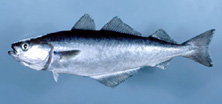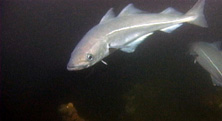Atlantic Pollock (Pollachius virens)
- The most recent assessment shows that Atlantic pollock has declined below sustainable levels. The stock is currently considered not overfished and not subject to overfishing, but the status will change when these new assessment results are finalized.
- Management measures for pollock aim to reduce fishing mortality to allow stocks to rebuild and to then remain at or near target levels.
- Atlantic pollock is very low in saturated fat and is a very good source of protein, vitamin B12, phosphorus, and selenium. For more on nutrition, see Nutrition Facts. (USDA)
- Only about 2% of the pollock landed in the U.S. comes from Atlantic pollock stocks; the rest is Alaska pollock, a different species found in the Pacific Ocean.
|
 |
 |
 |
 |
| Nutrition Facts |
| Servings 1 |
| Serving Weight
100g |
 |
| Amount Per Serving |
 |
| Calories 92 |
 |
| Total Fat |
0.98 g |
 |
| Total Saturated Fatty Acids |
0.135 g |
 |
| Carbohydrate |
0 g |
| Sugars |
0 g |
| Total Dietary
Fiber |
0 g |
 |
| Cholesterol |
71 mg |
 |
| Selenium |
36.5 mcg |
 |
| Sodium |
86 mg |
 |
| Protein |
19.44 g |
 |
|
 |
 A mate aboard the headboat Yankee Patriot out of Gloucester, Massachusetts, filleting pollock after an offshore bottom fishing trip to Georges Bank. A mate aboard the headboat Yankee Patriot out of Gloucester, Massachusetts, filleting pollock after an offshore bottom fishing trip to Georges Bank.
|
 |
Did you know?
Atlantic pollock is usually called pollock but is a different fish from the Alaska pollock.
Atlantic pollock is a member of the cod family but can be distinguished by its green hue and darker flesh.
Juvenile pollock (inshore) school in the open water at low tide, and disperse at high tide, hiding in intertidal algae (seaweed) beds.
|
|
| |
 |
|
Atlantic pollock are brownish green on the back and paler on the belly. They can be distinguished from cod by their greenish hue.
|
 |
|
Atlantic pollock are highly migratory, traveling between the Scotian Shelf and Georges Bank and, to a lesser extent, between the Scotian Shelf and the Gulf of Maine.
|
|
Sustainability Status
Biomass: The biomass of Atlantic pollock is 43% of the biomass needed to support maximum sustainable yield.
Overfishing: No*
Overfished: No*
Fishing and habitat: Atlantic pollock are commercially caught with bottom trawls and gillnets. Each of these types of gears can have a negative impact on the benthic habitat, the severity of which depends on the type of particular habitat (e.g., sandy, rocky, stable, or subject to frequent natural disturbance, etc).
Bycatch: Both otter trawls and gillnets will catch a variety of species and sizes of fish, depending upon their mesh size, and method of use. Therefore, vessels targeting pollock may catch other species, and vessels targeting other species may catch pollock.
Aquaculture: There is currently no commercial aquaculture of pollock in the U.S.
*This stock is currently considered not subject to overfishing and not overfished. However, based on the most recent stock assessment published in September 2008, the status will change to subject to overfishing and approaching an overfished condition if the results are finalized.
|
Science and Management
The U.S. portion of the Atlantic pollock fishery is managed under the New England Fishery Management Council's Northeast Multispecies Fishery Management Plan (FMP). Pollock are included in a complex of 15 groundfish species managed by time/area closures, gear restrictions, minimum size limits, and direct effort controls including a moratorium on permits and days-at-sea restrictions. The goal of the management program is to reduce fishing mortality to allow stocks to rebuild above minimum biomass thresholds and then to remain at or near target biomass levels. Amendment 13 implemented formal rebuilding plans with specified time frames based on revised biomass and fishing mortality targets.
|
Life History and Habitat
Life history, including information on the habitat, growth, feeding, and reproduction of a species, is important because it affects how a fishery is managed.
- Geographic range: Atlantic pollock is found on both sides of the North Atlantic Ocean, but there is a different species, Pollachius pollachius (commonly known as saithe) in the Eastern Atlantic. In the Northwest Atlantic, the species is most abundant on the western Scotian Shelf and in the Gulf of Maine.
- Habitat: Pollock eggs and larvae are found in the water column. Juveniles are common in inshore areas but move offshore as they grow older. They have been reported over a wide variety of substrates including sand, mud, or rocky bottom and vegetation. Adults show little preference for bottom type.
- Life span: Pollock are long-lived and can reach a maximum age of 23 years.
- Food: Smaller pollock in inshore waters feed on small crustaceans (copepods, amphipods, and euphausiids) and small fish, while larger pollock prey predominantly upon fish.
- Growth rate: Pollock grow rapidly until they sexually mature.
- Maximum size: Up to 43 inches in length and 35 pounds in weight.
- Reaches reproductive maturity: By age 6, although the majority are mature before age 3.
- Reproduction: Atlantic pollock spawn multiple times per season. Pollock eggs rise into the water column after they are fertilized. Little else is known about the actual spawning event.
- Spawning season: From November through February, with peaks in December.
- Spawning grounds: Spawning occurs over hard, stony, or rocky bottom. Pollock spawn in scattered locations in the Gulf of Maine and Georges Bank, most notably, eastern Stellwagen Bank, Jeffrey's Ledge, the Northeast Peak of Georges Bank, and the Great South Channel.
- Migrations: Pollock are highly migratory. Tagging studies suggest considerable movement of pollock between the Scotian Shelf and Georges Bank and, to a lesser extent, between the Scotian Shelf and the Gulf of Maine. Pollock are a schooling species.
- Predators: As juveniles they are preyed upon by a variety of other fish species, and as an adult are preyed upon by spiny dogfish, monkfish, and other pollock.
- Commercial or recreational interest: Both
- Distinguishing characteristics: Atlantic pollock are brownish-green on the back and slightly paler on the belly. They have a small chin barbel, like the whiskers on a catfish.
|
Role in the Ecosystem
Smaller pollock in inshore waters feed on small crustaceans and small fish, while larger pollock prey predominantly upon fish. As juveniles, they are preyed upon by a variety of other fish species, and adults are preyed upon by spiny dogfish, monkfish, and other pollock.
|
Additional Information
Market name: Pollock
Vernacular names: Saithe, Coalfish, Coley, Green Cod, Boston Bluefish
|
Biomass
 Biomass refers to the amount of Atlantic pollock in the ocean. Scientists cannot collect and weigh every single fish to determine biomass, so they use models to estimate it instead. These biomass estimates can help determine if a stock is being fished too heavily or if it may be able to tolerate more fishing pressure. Managers can then make appropriate changes in the regulations of the fishery. Biomass refers to the amount of Atlantic pollock in the ocean. Scientists cannot collect and weigh every single fish to determine biomass, so they use models to estimate it instead. These biomass estimates can help determine if a stock is being fished too heavily or if it may be able to tolerate more fishing pressure. Managers can then make appropriate changes in the regulations of the fishery.
Biomass indices have varied considerably since 1963. Indices generally fluctuated between 2 and 5 kilograms per tow throughout most of the 1960s and 1970s, peaking at over 8 kilograms per tow in 1976, after good recruitment in the early 1970s. Biomass indices declined rapidly during the early 1980s and continued to decline steadily through the early 1990s, remaining below 1 kilogram per tow and reaching a minimum during the mid-1990s. Since then, biomass indices have generally increased, fluctuating after 2000 between 2 and 2.5 kilograms per tow. Current biomass indices are now below those obtained between 2001 and 2005.
Note: Biomass indices from the Northeast Fisheries Science Center's fall survey are shown in the graph.
Landings
 Landings refer to the amount of catch that is brought to land. Total landings from Georges Bank and the Gulf of Maine increased steadily from less than 10,000 metric tons during the 1960s to a peak of over 26,000 metric tons in 1986. Landings declined sharply during the late 1980s and have remained below 10,000 metric tons throughout most of the 1990s. Total commercial landings since 1999 have fluctuated between 5,200 and 9,000 metric tons. Landings refer to the amount of catch that is brought to land. Total landings from Georges Bank and the Gulf of Maine increased steadily from less than 10,000 metric tons during the 1960s to a peak of over 26,000 metric tons in 1986. Landings declined sharply during the late 1980s and have remained below 10,000 metric tons throughout most of the 1990s. Total commercial landings since 1999 have fluctuated between 5,200 and 9,000 metric tons.
Note: The commercial landings presented include Canadian landings, but the majority is taken by the U.S. in this area.
Biomass and Landings
 Are landings and biomass related? Landings are dependent on biomass, management measures in the fishery, and fishing effort.
Are landings and biomass related? Landings are dependent on biomass, management measures in the fishery, and fishing effort.
Data sources:
Biomass and landings from Northeast Fisheries Science Center Assessment of 19 Northeast Groundfish Stocks through 2007
|
Important Dates
1960s – Landings steady around 10,000 metric tons
1976 – Biomass indices peak
Early 1980s – Biomass indices decline rapidly
1986 – Northeast Multispecies FMP implemented; landings are over 26,000 metric tons
1980s – Directed bottom trawling for pollock increases steadily (pollock have previously been taken as bycatch in various bottom trawl fisheries)
1986-1987 – Trawl effort peaks
Late 1980s – Landings decline sharply
Mid-1990s – Biomass indices reach minimum
2000 – Biomass increases and remains steady in future years
2003 – Atlantic pollock no longer overfished
2007 – Biomass declines below half of the biomass level needed to support maximum sustainable yield
2008 – Atlantic pollock is overfished and overfishing is occurring
|
Notes and Links
General Information:
Status of Fishery Resources off the Northeastern U.S. - Atlantic Pollock
Northeast Fisheries Science Center - Species Information: Pollock
Pollock, Pollachius virens, Life History and Habitat Characteristics
Fishery Management:
Northeast Multispecies Fishery Management Plan
Northeast Multispecies Fishery Management Plan - Summary
Northeast Multispecies Fishery Management Plan - Amendments
Northeast Multispecies Fishery Management Plan - Framework Adjustments
Stock Assessments:
Northeast Fisheries Science Center Assessment of 19 Northeast Groundfish Stocks through 2007
|
| |
|



